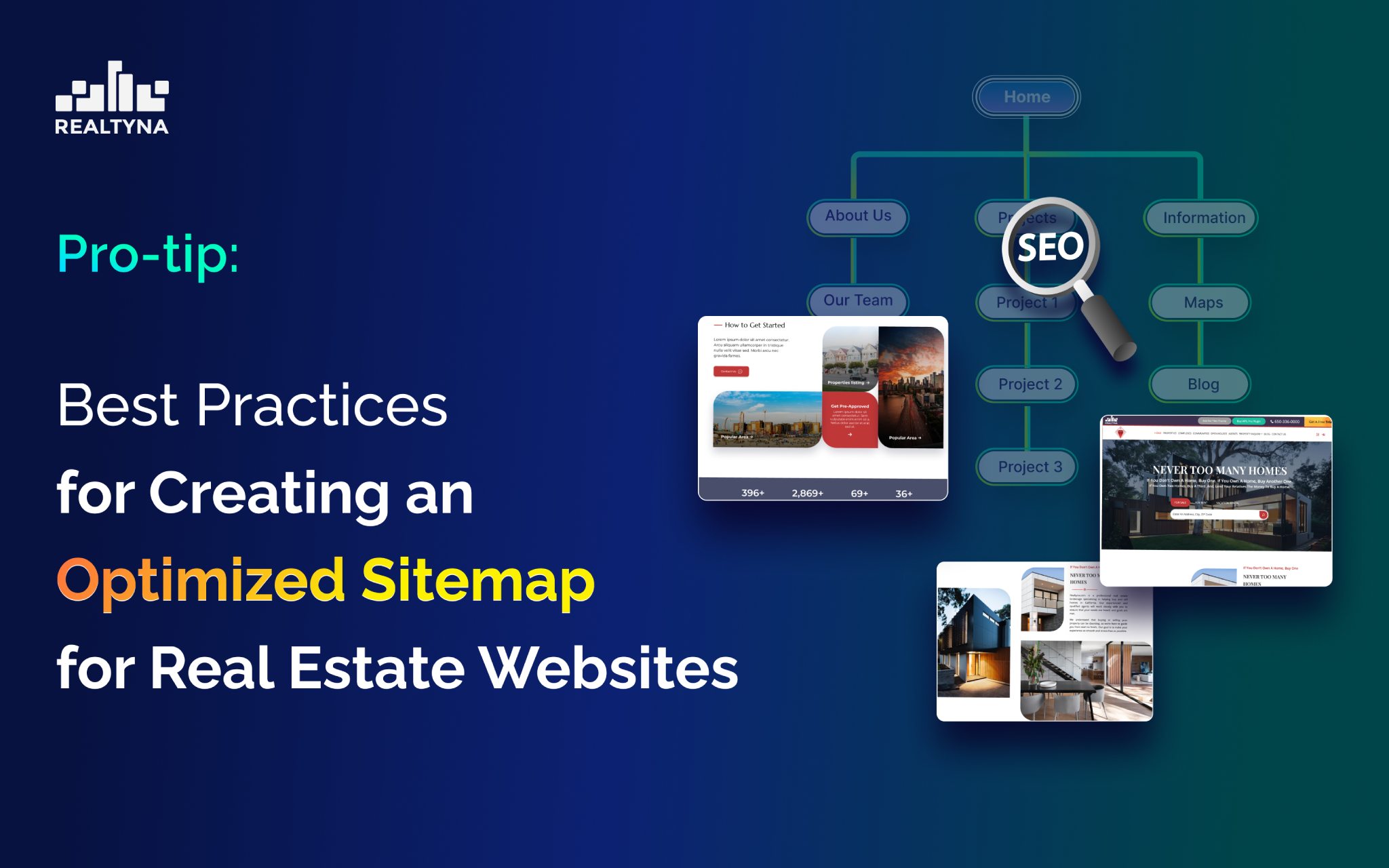
The Ultimate Guide to Sitemaps for Real Estate Websites
A sitemap is a file that lists all of the important pages on your website, along with additional information about each page. Sitemaps are important for search engine optimization (SEO) because they help search engines crawl and index your website more effectively. This can lead to improved search engine rankings and increased organic traffic and can be helpful in fixing indexing issues.
An optimized sitemap is especially important for real estate websites, which can often be large and complex. A well-structured sitemap can help search engines understand the hierarchy of your website and the relationships between different pages. This can make it easier for search engines to find and rank the most important pages on your website.
Sitemap optimization is one small part of the SEO process, if you’re interested in having a good knowledge about how to optimized your real estate website for search engines, check our our comprehensive guide on Real Estate SEO.
What is a sitemap and why is it important for real estate websites?
A sitemap is a file that provides a roadmap of your website’s structure to search engines. It lists all the pages on your website, including their URLs, and can include additional information such as the last modified date and the frequency of changes. By providing this information, a sitemap helps search engines understand the organization of your website and its content.
For real estate websites, which often have a large number of pages and listings, a sitemap is crucial. These websites typically have various categories such as property types, locations, and price ranges. Without a well-structured sitemap, search engines may struggle to navigate through the complex web of pages, potentially missing important content. An optimized sitemap ensures that search engines can easily crawl and index all relevant pages, improving the visibility of your real estate website in search engine results.
How an Optimized Sitemap Improves Search Engine Visibility
Sitemaps play a crucial role in enhancing the efficiency of search engine crawling and indexing processes for your website. Search engines employ crawlers to navigate the internet and discover new web pages. By providing a clear roadmap of your website, sitemaps facilitate the crawlers in locating and indexing all of your pages effectively.
Moreover, sitemaps aid search engines in comprehending the structure and hierarchy of your website. They enable you to indicate the relative importance of different pages on your website and establish the relationships between them. This valuable information assists search engines in gaining a better understanding of your website’s content and ranking it more accurately in search results.
Furthermore, sitemaps serve as a means for search engines to identify and rectify any indexing errors. When a search engine accesses your sitemap, it promptly detects any errors such as broken links or missing pages. This allows you to promptly address these issues, thereby contributing to the overall quality of your website.
Additionally, sitemaps facilitate communication between you and search engines regarding any changes made to your website. If you add or remove pages from your website, updating your sitemap to reflect these changes is essential. This ensures that search engines maintain an up-to-date index of your website, enabling them to promptly crawl and index your new or updated pages.
Best practices for creating an optimized sitemap for real estate websites

Creating an optimized sitemap requires careful planning and attention to detail. Here are some best practices to consider when creating a sitemap for your real estate website:
1. Organize your sitemap by categories and subcategories
To make it easier for search engines to understand the structure of your real estate website, organize your sitemap by categories and subcategories. For example, you could have categories for property types (e.g., houses, apartments, condos), locations (e.g., cities, neighborhoods), and price ranges. Within each category, create subcategories if necessary to further refine the hierarchy of your sitemap.
2. Include all relevant pages and listings
Ensure that your sitemap includes all relevant pages and listings on your real estate website. This includes property detail pages, search result pages, blog posts, and any other content that you want search engines to index. Remember to update your sitemap whenever you add new pages or remove old ones to keep it accurate and up to date.
3. Optimize your URLs
When creating URLs for your real estate website, use descriptive and keyword-rich terms. This not only helps search engines understand the content of your pages but also improves the user experience. Avoid using generic and meaningless URLs, such as “www.example.com/page1,” and instead opt for URLs like “www.example.com/houses-for-sale-in-new-york-city.”
4. Use XML sitemap format
XML (Extensible Markup Language) is the preferred format for sitemaps. XML sitemaps are easy for search engines to read and understand, and they provide additional information such as the last modified date and the priority of each page. Use a sitemap generator tool or a content management system (CMS) plugin to automatically generate and update your XML sitemap.
Once you have created and optimized your sitemap, it’s important to submit it to search engines. Here’s how you can do it:
How to submit your sitemap to search engines
Submitting your sitemap to search engines is a crucial step in optimizing your real estate website. By doing so, you can ensure that search engines are aware of all the pages on your website and can index them properly. Here are some steps to follow when submitting your sitemap:
1. Generate a sitemap: The first step is to generate a sitemap for your real estate website. There are several tools available that can help you create a sitemap automatically. One popular option is to use a plugin if you’re using a content management system like WordPress. These plugins can generate a sitemap for you and update it automatically whenever you add or remove pages from your website. If you are using the Realtyna WPL Platform, you can use the WPL Sitemap Feature to add your listing to your sitemap.
2. Verify your website: Before you can submit your sitemap, you need to verify that you are the owner of the website. This is done by adding a verification code or file to your website. The process for verification may vary depending on the search engine you are using. For example, if you’re using Google Search Console, you can verify your website by adding a meta tag or uploading an HTML file to your website’s root directory.
3. Submit it to search engines, Here’s how you can do it:
- Google Search Console
To submit your sitemap to Google, first, create a Google Search Console account if you haven’t already. Verify ownership of your real estate website, and then navigate to the “Sitemaps” section. Enter the URL of your sitemap (e.g., “www.example.com/sitemap.xml”) and click on the “Submit” button. Google will then start crawling and indexing your website based on the information provided in your sitemap.
- Bing Webmaster Tools
Bing Webmaster Tools is a similar platform to Google Search Console, but for Bing search engine. Sign in or create an account, and then add and verify your real estate website. Navigate to the “Sitemaps” section and enter the URL of your sitemap. Click on the “Submit” button to submit your sitemap to Bing for crawling and indexing.
Monitoring and updating your sitemap for optimal performance
Creating an optimized sitemap is not a one-time task. Real Estate SEO Experts regularly monitor and update sitemap to ensure optimal performance. Here are a few tips:
1. Regularly check for errors
Use the tools and plugins mentioned earlier to regularly check for any errors or issues with your sitemap. This includes broken links, missing pages, and any other issues that may prevent search engines from properly crawling and indexing your real estate website. Fix any errors promptly to maintain a healthy sitemap.
2. Monitor search engine performance
Keep an eye on your real estate website’s performance in search engine results. Monitor your organic traffic, rankings, and click-through rates to identify any changes or trends that may indicate issues with your sitemap or overall SEO strategy. Make adjustments as necessary to improve your website’s visibility and performance.
3. Update your sitemap when necessary
As your real estate website evolves, you may add new pages, remove old ones, or make changes to existing content. It’s important to update your sitemap whenever such changes occur to reflect the current state of your website. This ensures that search engines have the most up-to-date information about your real estate listings and pages. Most of the SEO Plugins will automatically update the sitemap when anything happens to pages.
3. Do Not add No-index pages to your sitemap
Sitemaps should include URLs that are Do-index, if you are using a robot meta tag to disallow Google bots to crawl your pages, you should not add these pages to your sitemap, otherwise, you will an error in Google Search Console.
Conclusion: The importance of an optimized sitemap for real estate websites
In conclusion, an optimized sitemap is a valuable asset for real estate websites. It improves search engine visibility and more. By following best practices and using the right tools and plugins, you can create and optimize a sitemap that helps your real estate website rank higher in search engine results.
As a real estate SEO expert, I recommend you don’t underestimate … the power of a well-structured sitemap in maximizing the potential of your real estate website.
If you care about your website performance in terms of SEO, it’s better to research more about this matter. Here are two articles you can start your journey:


Sorry, the comment form is closed at this time.